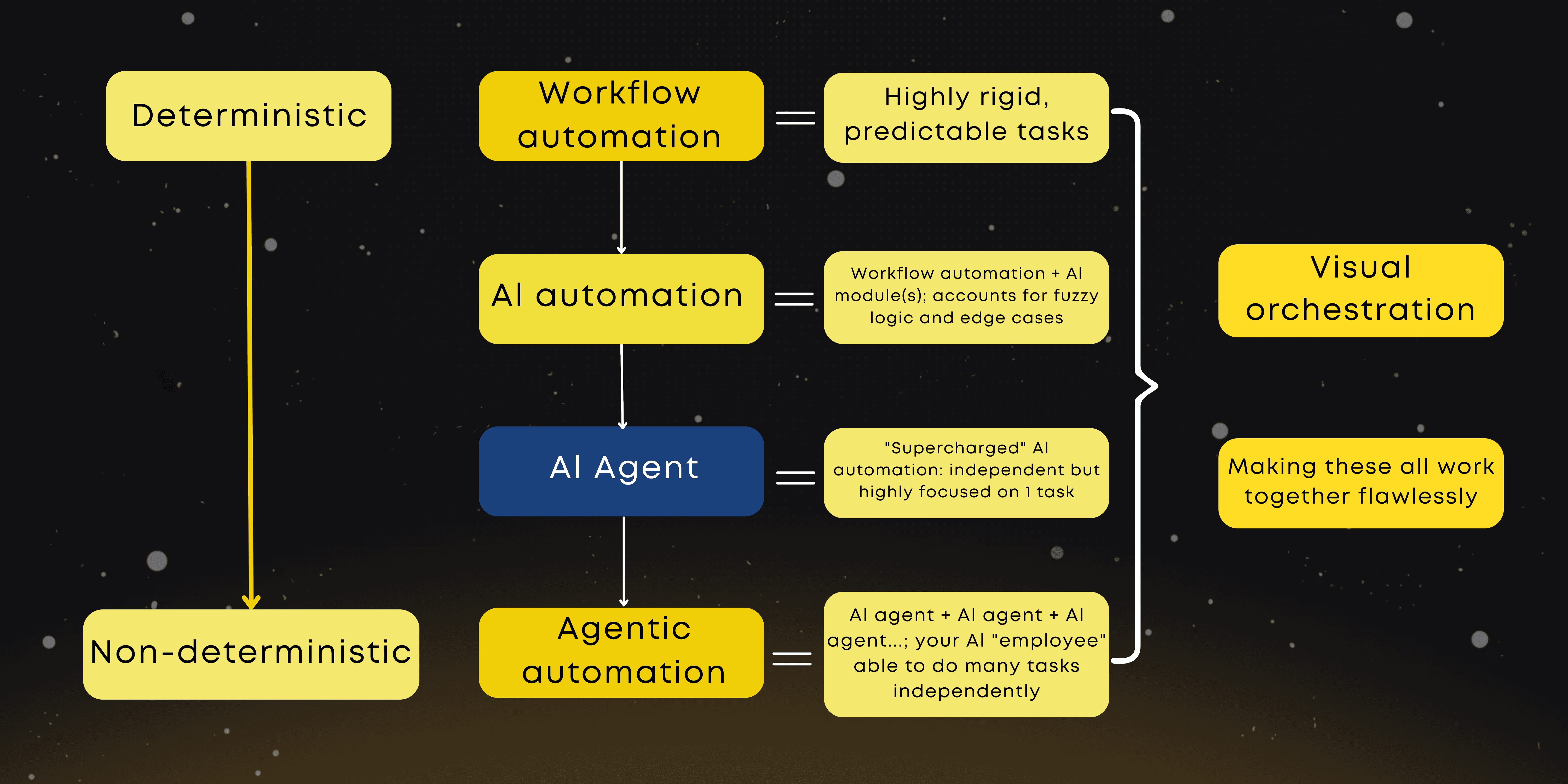The terms "AI agents" and "agentic automation" are often used interchangeably, but they're fundamentally different. Understanding this distinction will help you choose the right automation approach for your business needs and avoid costly setup mistakes.
Let's break down these concepts and see how they fit into your workflow automation strategy.
What is an AI agent?
An AI agent is an intelligent assistant that combines automation with decision-making capabilities. Unlike traditional workflows that follow rigid rules, AI agents can adapt to changing situations and make contextual decisions.
Every AI agent typically includes:
- Language processing: Understanding and generating natural language
- Context awareness: Access to relevant data for informed decisions
- Action tools: Ability to perform tasks like sending emails, updating records, or triggering workflows
The key characteristic of an AI agent is its goal-oriented focus. Whether it's qualifying leads, processing support tickets, or analyzing data, the agent stays focused on achieving one specific objective while adapting to different scenarios.
Example: A customer service AI agent that reads support emails, categorizes issues, and either responds directly or routes to the appropriate team member.
What is agentic automation?
Agentic automation scales individual AI agents into a coordinated network of intelligent assistants. Instead of one agent handling a single task, you deploy multiple agents that work together toward broader business objectives.
Think of it as orchestrating an entire AI workforce where agents:
- Share information across processes
- Hand off tasks to specialized agents
- Collaborate to achieve complex, multi-step outcomes
- Adapt collectively to changing business needs
Example: A complete lead management system where a qualification agent identifies prospects, a nurturing agent manages follow-ups, a scheduling agent books meetings, and an onboarding agent guides new customers.
Agentic automation vs AI agents
How we got here
The journey from simple rule-based workflows to today’s agentic automation has been gradual, shaped by years of innovation and evolving expectations of what automation should deliver. Let’s look at the progression:
- Rule-based automation. Early automation worked on strict “if this, then that” logic. It was reliable but rigid—any adjustment required manual reprogramming.
- Adaptive automation. With the rise of AI models, workflows gained flexibility. They could respond dynamically to new inputs and make decisions without every outcome being predefined.
- AI agents. Building on this adaptability, AI agents integrated language models, contextual awareness, and action tools. They focus on specific goals and can choose the best path to achieve them with minimal human oversight.
- Agentic automation. The latest stage links multiple AI agents into collaborative systems. Instead of working in isolation, agents share tasks and context, operating as an AI-driven workforce capable of managing complex, multi-step processes.
Together, these stages show how automation has evolved—from rigid rules, to adaptive intelligence, to goal-driven AI agents, and finally to agentic automation, where many agents coordinate as a unified team.

Benefits
AI Agents
- Quick deployment: Start automating specific tasks immediately
- Focused expertise: Deep specialization in particular processes
- Easy management: Simple to monitor and optimize single-purpose agents
- Clear ROI: Measurable impact on targeted business functions
Agentic Automation
- End-to-end coverage: Automate complete business processes
- Seamless handoffs: Agents share context for smooth transitions
- Scalable intelligence: Handle growing complexity without rebuilding
- Compound value: Multiple agents create exponentially better outcomes
Risks and challenges
AI Agents Challenges
- Limited scope: Each agent only handles one specific task
- Integration gaps: May not connect seamlessly with all your tools
- Context isolation: Limited visibility into broader business processes
- Quality control: Outputs need review to ensure accuracy
How Diaflow helps: Our visual workflow builder makes it easy to connect agents with 500+ pre-built integrations and real-time monitoring tools.
Agentic Automation Challenges
- Coordination complexity: Managing multiple agents requires careful orchestration
- Higher maintenance: More agents mean more configuration and monitoring
- Conflicting actions: Agents may duplicate work or work against each other
- Security considerations: Multiple autonomous agents need proper access controls
How Diaflow helps: Our centralized dashboard provides complete visibility across all agents, with built-in coordination tools and security controls.
Getting started with Diaflow
Whether you're building your first AI agent or designing agentic automation, Diaflow's no-code platform makes it accessible:
Start with AI Agents if you:
- Want quick wins on specific tasks
- Need to prove automation value first
- Have limited technical resources
- Prefer incremental improvements
Choose Agentic Automation if you:
- Ready to transform entire processes
- Have complex multi-step workflows
- Want comprehensive automation coverage
- Need agents to share context and coordinate
Ready to automate smarter?
Transform your workflows with Diaflow's visual automation platform. Build AI agents and agentic automation systems without coding complexity.
Explore Templates → Start Free Trial → Book Demo
FAQs
1. What’s the main difference between AI agents and agentic automation?
AI agents focus on a single, specific goal (like handling support tickets), while agentic automation connects multiple agents to work together across entire workflows.
2. When should I start with AI agents instead of jumping into agentic automation?
If you want quick wins and have a limited scope, start with AI agents. Once you’re ready to automate broader processes, you can scale into agentic automation.
3. What challenges come with agentic automation?
It requires careful coordination, monitoring, and access control because multiple agents are working simultaneously. Without the right platform, things can get complex fast.
4. How does Diaflow help?
Diaflow provides a no-code platform with 500+ integrations, real-time monitoring, and a centralized dashboard to manage both single AI agents and full agentic automation systems easily.

AI Agents vs Agentic Automation: Choosing the Right Path
AI agents are best for quick wins and targeted tasks, while agentic automation scales into complete, connected workflows. With Diaflow, you don’t have to choose one or the other—you can start small with AI agents and grow into agentic automation seamlessly. Our platform gives you the flexibility, integrations, and monitoring tools to adapt as your business evolves.



